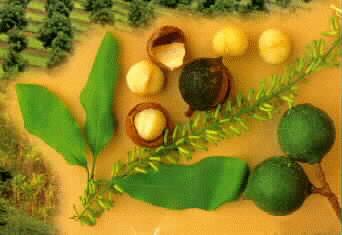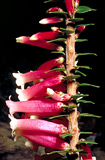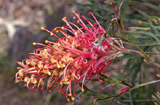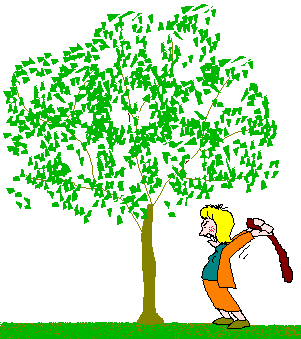|
[Front Page] [Features] [Departments] [SGAP Home Page] [Subscribe]

Electronic Mailbox
  The following have been selected from the questions received on the SGAP World Wide web site over the past few months and from contributions directed to the Electronic Mailbox specifically. You're welcome to comment on any issue concerning Australian native plants....growing, propagating or appreciating...anything.
The following have been selected from the questions received on the SGAP World Wide web site over the past few months and from contributions directed to the Electronic Mailbox specifically. You're welcome to comment on any issue concerning Australian native plants....growing, propagating or appreciating...anything.

Cracking up!
I've been browsing around trying to find some information on roasting macadamia nuts. I saw Mark Henley's page about macadamias and he mentions 'home-roasted' but doesn't elaborate. How long and how hot should I roast them? Presumably they should be roasted in the shells?
Are there any clever tricks to shelling raw macadamias? I've been using a hammer, just gently, and can get most nuts out whole but it's slow going. I'd like to be able to convince my wife that I'm not crazy when she sees me headed to the workshop with a bag of nuts.
Thanks for any info.
Chris Bone,
Australia
I know next to nothing about roasting macadamias...and none of my references help either. One bush food book ("Wild Lime" by Juleigh Robins) talks about oven roasting but doesn't mention temperature or time. I guess it's a case of trial and error (cook a couple until they explode and work backwards from there?) The book does however say that the nuts are roasted after shelling.
  I don't know if there are any cleaver tricks to shelling them....like you, most people just hit them with a hammer. The degree of effort to be applied comes with experience. The same reference book says that macadamia nut crackers can be purchased from specialist nut shops. It also says that they can be cracked by "steadying the round nut on a nest made from a tea towel and whacking them with a brick".
I don't know if there are any cleaver tricks to shelling them....like you, most people just hit them with a hammer. The degree of effort to be applied comes with experience. The same reference book says that macadamia nut crackers can be purchased from specialist nut shops. It also says that they can be cracked by "steadying the round nut on a nest made from a tea towel and whacking them with a brick".
Sometimes the simplest solutions are the best......
Photo: Australian Macadamia Society

Long Flowering Plants
I am a Landscape Architect in Seattle doing research for plant material. I found your very attractive SGAP Home Page (good job!), and thought perhaps you or some of your colleagues might be able to help me. A client in Hawaii is trying to establish a private botanical garden
(Foundation-run, open to the public), centered on a theme of trees and shrubs which are ever-blooming. As you well know, most plants bloom in response to an environmental stimulus, rather than throughout the year, so the plant list is a bit short at the moment. I am familiar with some of the more common ever-blooming tropicals, such as hibiscus, bougainvillea, etc. I am looking for advice on other trees and shrubs which might fit in as well. This part of Hawaii is very hot and dry (10 inches rainfall annually, although irrigation is being installed).
This is a preliminary search to test the feasibility of the idea. One question to be resolved in the case of each species the degree to which it presents a threat of invasiveness to the local ecology. Hawaiian species suffers greatly from the pressure of introduced exotics, and we
do not want to add to that pressure. If you have any suggestions of woody plants which potentially fit the description, please let me know.
Joe Cloud,
Seattle, Washington
I've been scratching my head over this question for a few days and haven't come up with many ideas. The group of plants which comes to mind are the so-called "Queensland hybrid" Grevilleas. Some of these are well known in the USA (at least in California) and all are either long flowering or flower throughout the year here. The best known in this group are "Robyn Gordon", "Ned Kelly" (also known as "Mason's Hybrid" and "Kentlyn"), "Superb", "Honey Gem", "Sandra Gordon", "Misty Pink", "Majestic" and "Sylvia". A hot, dry climate should suit these if irrigation is available.
I referred the question to John Wrigley, a well known authority on the horticulture of Australian plants and he responded as follows:
"I own a garden with some 2500 species of plants about 60% of which are native to Australia. Their flowering is recorded on computer with monthly checks being carried out. The following list shows those that have been recorded as flowering in every month.
| |
- Brachyscome 'Valencia' (herb)
- Brachyscome multifida (herb)
- Bracteantha bracteata (syn. Helichrysum bracteata) (perennial form)
- Epacris longiflora
- Grevillea 'Bronze Rambler'
- Grevillea 'Robyn Gordon'
- Grevillea 'Superb'
- Grevillea 'Sylvia'
- Grevillea banksii (produces copious seed; may become weedy)
- Grevillea parallela
- Mackinlaya macrosciadia
- Viola hederacea (herb)
- Westringia 'Wynyabbie Gem'
- Westringia fruticosa
- * Evolvulus pilosa
- * Pentas lanceolata
- * Serissa foetida
- * Thunbergia grandiflora (may become weedy)
- * Several Salvia spp. (may become weedy)
* = not native to Australia
Select the thumbnail image or plant name for a higher resolution image
|  |
| Epacris longiflora (19k) |
 |
| Grevillea "Superb" (41k) |
|
Hope this may be some help.
John Wrigley,
Horticultural Consultant,
P. O. Box 1639,
Coffs Harbour, NSW, 2450

Poisonous Pines and Close Eucalypts
I planted a Norfolk Island pine amongst some Australian natives (my wife loves these pines). A friend told us recently that the pine needles that fall to the ground are poisonous to all Australian plants and do in time kill off all plants around the fall perimeter. Is this true?
Could you also advise what should be the desired distance one separate the planting of eucalypts as I feel that I may have planted some too close together (2 metres).
Ian Phillips,
Australia
I can't categorically rule out some toxic effect of leaves from Norfolk Island pines (Araucaria heterophylla) but it's something I haven't heard of before. Sometimes it's difficult to maintain smaller plants in the root zone of large trees simply because the trees take up most of the water and nutrients leaving the smaller plants to struggle. I suspect this might be the case with the Norfolk Pine rather than a toxicity problem but perhaps a reader may have a definitive answer.
As far as the spacing of ecalypts is concerned, 2 metres sounds OK to me! The desired distance really depends on what effect you are trying to achieve. In nature large eucalypts often occur much closer than 2 metres apart and do quite well. So if you're after a natural appearance I think its a good idea to stagger the placement of trees - some fairly close and some further away. I have several well established Spotted Gums (Corymbia maculata) inside a 2 metre radius and looking great.

No Flames here!
I live in San Diego, California and need some advice regarding a Flame Tree (Brachychiton acerifolius) that I planted approximately four years ago. While it has grown in height, it has never produced blossoms, no matter what I do. I fertilize it, water it, etc., but it just doesn't flower. Any suggestions?
Janet Kreger,
San Diego, California
Unfortunately, no. The flame tree is one of Australia's most spectacular flowering trees but they are renowned for taking a long time to flower from seed. I wouldn't expect flowering for about 7 years and sometimes they can take much longer. Not a very satisfactory answer, I know. Another feature of flame trees is that they will sometimes flower on only one half of the tree. Is that idiosyncratic, or what?
  The only suggestion I can make is to cut back the fertilizing. It's possible that fertilizing could be producing foliage at the expense of flowers. Some of the best flowering specimens I have seen have been growing in fairly harsh conditions on clay soils....no artificial watering and little or no fertilizer (not exactly the sort of conditions it would experience in its natural rainforest environment but it does emphasise the versatility of the plant). It's possible that giving the tree a bit of stress can force it to flower.
The only suggestion I can make is to cut back the fertilizing. It's possible that fertilizing could be producing foliage at the expense of flowers. Some of the best flowering specimens I have seen have been growing in fairly harsh conditions on clay soils....no artificial watering and little or no fertilizer (not exactly the sort of conditions it would experience in its natural rainforest environment but it does emphasise the versatility of the plant). It's possible that giving the tree a bit of stress can force it to flower.
Speaking of stress......A well know TV/Radio gardening guru here has been known to suggest giving recalcitrant flame trees a good thrashing (Literally! With a large lump of wood). Now THAT'S what I call causing stress! I haven't tried this method but, if you're desperate for flowers, have a large lump of wood handy and don't mind what the neighbours say......

Wollemi Wanted
I have just been visiting your site again and noticed the article about the Wollemi pine. Wow is that ever exciting!! I can't believe I hadn't heard of this discovery until now. I love the Araucariaceae family even more than the Proteaceae. Oh how will I sleep now??
Could you please give me the address, fax, or e-mail address of the botanical garden where testing is taking place. The city in which I live (Vancouver) has a mild climate suitable for the outdoor cultivation of a number of the Araucariaceae. I would like to try to obtain seed or plantlets of the Wollemi pine for testing the viability of nursery cultivation in this area. I realize this is an unlikely prospect but it sure would be an exciting thesis project to undertake.
Brad Estergaard,
Vancouver, BC, Canada
How can anyone love conifers more than Proteaceae!!!!!!
You will probably have trouble getting hold of a plant in the short term and I suspect that seed is out of the question....the plant is that rare.
However, recent reports indicate that propagation of the plant has been very successful and the Royal Botanic Gardens Sydney (which is doing the research) recently advertised for commercial partners to help in propagating and marketing the plant. It is anticipated that plants might be released to the public in 1998.
The Royal Botanic Gardens web site has further information on the Wollemi pine (Wollemia nobilis) and I expect that details of its availablity will be posted there in due course.

The Weeping Princess
I would like to know all information on growing from seed to tree Eucalyptus caesia "Silver Princess", weeping gum. What conditions does it need and is it suitable for Melbourne's climate?
Bev Car,
Melbourne, Australia
Yes it's certainly suited to Melbourne (not so for Sydney, worse luck!). It grows well in any Mediterranean-type climate and should be OK on most soils provided the drainage is reasonable and plenty of sunshine is available.
For those who aren't familiar with this plant, it is a small tree to about 5-6 metres with a fairly open habit and weeping branches. Leaves are oblong in shape and greyish green. The large flowers are very conspicuous and are light to deep pink in colour. In short, a most desirable plant if you live in the right area.
 
The large, colourful flowers of Eucalyptus caesia, are among the most spectacular of all of the "gum trees". Select the thumbnail image or plant name for a higher resolution image (33k).
Eucalypts, in general, are not difficult to propagate from seed (see our Plant Propagation pages for details of seed raising).
The only problem with growing plants from seed is that they may not come true to the parent plant. "Silver Princess" seems less variable than most but there could be variations in the flower colour from light to deep pink. Unfortunately there is no practical alternative to seed propagation for this particular plant.

Bush Regeneration
I am delighted to see so much material coming to light concerning the Bradley Method of bush regeneration. I suppose my love affair with the method (or at least the idea) started when I chanced upon this insignificant looking little paper-back in the local council library called 'The Bradley Method'. Well, I'm glad I got it out because I couldn't put it down until it was finished and then I re-read it.
I am actually using the method with great success on some land we purchased at Fernvale, near Ipswich. The main pest we are trying to eliminate is a small leaved lantana. At last, we are finding it more and more difficult to find the stuff, so we are certainly winning.
Whilst I am converted to the method, I was most distressed when a lady at a SGAP meeting I was attending, loudly proclaimed that the methods used to regenerate the bush at one particular site weren't working because she couldn't see where they had been!!! She wasn't able to say if she could see any weeds though. I think the best any of us can hope for is EDUCATION, EDUCATION and more EDUCATION.
Anyway, keep up the good work. It is appreciated.
Margaret Van Emmerik,
Brisbane, Queensland
Thanks, Margaret. It's nice to get some positive feedback.
The Bradley Method has a dedicated band of followers but the average person finds it frustrating because there is little immediate benefit visible. There's a bit more on the method on the Society's new "Weeds Page".

Oz Plants for North America
G'day, lovely site you have and lovely plants, too. Apparently it's not a Frequently Asked Question but I'd like to know if Grevillea, or any Australian natives, can be grown in North America. I live in the southern US and don't know how our climate compares. Can you tell me where I could find information on the characteristics of Australian zones? I don't know whether I'm just overlooking it at your site or whether I need to search elsewhere.
Kate Lykins,
USA
G'day back to you, Kate! Thanks for the comments. I'm glad you like the site.
Australian plants can certainly be grown in the USA. A lot are grown in California and the Arboretum at Santa Cruz has an extensive collection. The main barrier to successful cultivation is the very cold winters that occur in many American states. Most of the Australian plants in general cultivation are not adapted to extreme winter temperatures. However, if your winters are relatively mild (down to, say, -10 degrees C), there would seem to be no reason why you couldn't grow a good range of Australian species. The main difficulty would be in getting hold of the plants - you may have to grow your own from seed.
There is no direct comparison between USDA climate zones and Australian climate zones. You can get a rough idea of the climates for the various Australian states at our "Regional and District Groups" section and more detailed info at the Australian Bureau of Meteorology site.
Just one word of warning. Plants from other parts of the globe can become weedy if introduced into an area where no natural controls exist. For example, Melaleuca quinquenervia, a very popular Australian landscaping tree and one which causes no problems here, has caused extensive damage in the Florida everglades by displacing native vegetation.

Susan with a Black Eye!
I live in Northern California and have found that a number of Australian plants do really well in my garden along with my collection of California, South African, and other mediterranean plants.
A number of years ago I purchased a Tetratheca thymifolia. It has been a marvelous plant for me blooming every year for a long time in winter. In fact right now it is really stunning and has been for quite awhile. It survived the extremely cold temperatures we had here in 1990 when I lost some of my other Australian plants. I would like to have more plants, but never see it for sale anywhere. I've looked for seed, but couldn't tell what was seed and whatever I saved never came up. I tried to take cuttings and I did get one to root, but after I planted it out it has not grown at all. It hasn't died either, but I have to look really hard to even find it after several years in the ground. Can anyone help me with propagating more of this wonderful plant?
Mary Sue Ittner,
California, USA
I have a bit of experience with T.thymifolia but not all good! It's certainly a great plant and the best one I grew was in a container. I've found the species strikes well on some occasions but not so well at other times. I think the best time to take cuttings is late summer when the current season's growth has hardened. I generally take cuttings about 75mm (3") long and "wound" the lower 10mm (1/2") - the wound is the removal of a small sliver of stem to expose more cambium layer. I use a medium strength cutting hormone, liquid by preference but powder if that is all that's available). The cuttings are placed in a sand/peat moss mix (about 70/30) in a humid plastic enclosure. Cuttings usually strike in 6-8 weeks.
 
Tetratheca thymifolia, makes a spectacular container plant. Tetratheca species are sometimes called "Black-eyed Susan" because of the dark throat of the flower - they are not related to the exotic Thunbergia (also called "Black-eyed Susan") which is a serious weed in Australia. Select the thumbnail image or plant name for a higher resolution image (41k).
Your experience with the plant you got to strike mirrors mine. For some reason apparently healthy cuttings will struggle while others from the same batch grow on well. I don't know the answer to this but I would be inclined to dig up the one in the garden that's not moving and put it in a container to see if growth can be encouraged.
Not a lot of help, I'm afraid, but I hope you get something out of it.

Eucs in California
I live on a private street of nine houses built in 1937-1942 in a grove of some 30 eucalyptus trees in Altadena, California. I wonder if anyone can help me find out when these trees were planted and what for. I am told people thought eucalypts would make good telephone poles; others say misguided homesteaders planted the trees for lumber as a source of retirement income. One source says the trees are 80 years old. I plan to obtain county records for my specific property, but I thought perhaps someone had done a history of Eucalyptus plantings in California that someone could refer me to. Thank you for any help you can offer. (I am, of course, in seventh heaven to be living among these towering, graceful trees, and I even like leaving the leaves and bark on the ground as a design.)
Engels Polen,
California, USA
So do I!
Perhaps someone out there may be able to help but your best bet might be to enquire at Arboretum at Santa Cruz. The staff there may have some information on the history of these plants.
A year or so ago there was a discussion of Californian eucalypts on the mailing list Medit-Plants. Here's a sampling of some of the comments of Californians:
- "...Just wanted to answer what I know about Eucalyptus in California (Iím no expert). My understanding is that Eucalyptus were originally imported to be grown for lumber for railroad ties when the railroads were being built in California. Turns out the kind that were imported were the wrong kind, and were not able to be used (too much sap? too twisted? cracked too easily?) Eucalyptus have been used extensively for windbreaks in agricultural areas, and have grown well given the similarity of climates.
What California native plant purists donít like about eucs are that they tend to preclude anything else growing around them (like Californian natives). They are also seen as particularly dangerous for fire reasons, because they have so much litter (bark, leaves) and can create a "fire ladder" where a grass fire low to the ground can catch and be carried up to the tree/house tops."
- "I have to say that, even though Eucalyptus is not a California native, I think that they are so much a part of the landscape that I couldnít imagine living here without them. I have read that their narrow, pendulous leaves condense fog and remove significant moisture from the atmosphere that way, troubling native species that depend on getting their water from the air. But thatís the only bad thing I can say about them."
- "I wouldnít say that Eucalyptus are unwanted over here. I grew up in San Diego, California - in a development that was originally planted by a Mr Scripts in 1000ís of Eucalypts. Unfortunately he thought they would make great railroad ties. Bummer of an idea. Anyway - the trees are the signature of the community and are incredibly beautiful so long as they donít drop branches on your head. If you look around the native scrub areas, they look very barren. Add a few Eucalyptus and itís transformed. They thrive on neglect ...filling the canyons where nothing else could grow on around 12" of water each year. Just because a plant is not native, I donít think you should scorn it. It is a great windbreak and provides wonderful shade on hot days. Its brittleness and the possible fire-hazardness(?) are the only faults in my eyes!
Another bonus is that the San Diego Zoo has lots of feed for its Koalas!"
- "...Iíve been told by Australians that Eucalypts actually grow better here than in Australia because few of their pests were imported. The trees are certainly very vigorous.
In some areas they are a fire hazard. Eucalypts were blamed in part for the massive house-consuming fire in Oakland several years back.
In some areas they have run wild, producing dense groves of trees that crowd out everything else. I can think of one spot in Marin (north of San Francisco), along the road to Muir Beach, which is either a lovely Eucalyptus glade or an eyesore, depending on your opinion. There was some discussion about cutting down that grove at one time."
There was also an article in "Pacific Horticulture" (56(3), 1995) by Harriet Heyman called "Blue Gum Fever". This article looks into some of the historical facts. I think this magazine is published by the Californian Horticultural Society.
Hope this is of some help.
 [Front Page] [Features] [Departments] [SGAP Home Page] [Subscribe]
[Front Page] [Features] [Departments] [SGAP Home Page] [Subscribe]
Australian Plants online - June 1997
The Society for Growing Australian Plants
|